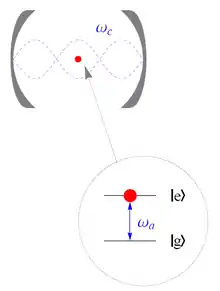Jaynes–Cummings–Hubbard model
The Jaynes–Cummings–Hubbard (JCH) model is a many-body quantum system modeling the quantum phase transition of light. As the name suggests, the Jaynes–Cummings–Hubbard model is a variant on the Jaynes–Cummings model; a one-dimensional JCH model consists of a chain of N coupled single-mode cavities, each with a two-level atom. Unlike in the competing Bose–Hubbard model, Jaynes–Cummings–Hubbard dynamics depend on photonic and atomic degrees of freedom and hence require strong-coupling theory for treatment.[1] One method for realizing an experimental model of the system uses circularly-linked superconducting qubits.[2]


History
The JCH model was originally proposed in June 2006 in the context of Mott transitions for strongly interacting photons in coupled cavity arrays.[3] A different interaction scheme was synchronically suggested, wherein four level atoms interacted with external fields, leading to polaritons with strongly correlated dynamics.[4]
Properties
Using mean-field theory to predict the phase diagram of the JCH model, the JCH model should exhibit Mott insulator and superfluid phases.[5]
Hamiltonian
The Hamiltonian of the JCH model is ():
where are Pauli operators for the two-level atom at the n-th cavity. The is the tunneling rate between neighboring cavities, and is the vacuum Rabi frequency which characterizes to the photon-atom interaction strength. The cavity frequency is and atomic transition frequency is . The cavities are treated as periodic, so that the cavity labelled by n = N+1 corresponds to the cavity n = 1.[3] Note that the model exhibits quantum tunneling; this process is similar to the Josephson effect.[6][7]
Defining the photonic and atomic excitation number operators as and , the total number of excitations is a conserved quantity, i.e., .
Two-polariton bound states
The JCH Hamiltonian supports two-polariton bound states when the photon-atom interaction is sufficiently strong. In particular, the two polaritons associated with the bound states exhibit a strong correlation such that they stay close to each other in position space.[8] This process is similar to the formation of a bound pair of repulsive bosonic atoms in an optical lattice.[9][10][11]
Further reading
- D. F. Walls and G. J. Milburn (1995), Quantum Optics, Springer-Verlag.
References
- Schmidt, S.; Blatter, G. (Aug 2009). "Strong Coupling Theory for the Jaynes-Cummings-Hubbard Model". Phys. Rev. Lett. 103 (8): 086403. arXiv:0905.3344. Bibcode:2009PhRvL.103h6403S. doi:10.1103/PhysRevLett.103.086403. PMID 19792743. S2CID 32092406.
- A. Nunnenkamp; Jens Koch; S. M. Girvin (2011). "Synthetic gauge fields and homodyne transmission in Jaynes-Cummings lattices". New Journal of Physics. 13 (9): 095008. arXiv:1105.1817. Bibcode:2011NJPh...13i5008N. doi:10.1088/1367-2630/13/9/095008. S2CID 118557639.
- D. G. Angelakis; M. F. Santos; S. Bose (2007). "Photon-blockade-induced Mott transitions and XY spin models in coupled cavity arrays". Physical Review A. 76 (3): 1805(R). arXiv:quant-ph/0606159. Bibcode:2007PhRvA..76c1805A. doi:10.1103/physreva.76.031805. S2CID 44490741.
- M. J. Hartmann, F. G. S. L. Brandão and M. B. Plenio (2006). "Strongly interacting polaritons in coupled arrays of cavities". Nature Physics. 2 (12): 849–855. arXiv:quant-ph/0606097. Bibcode:2006NatPh...2..849H. doi:10.1038/nphys462. S2CID 9122839.
- A. D. Greentree; C. Tahan; J. H. Cole; L. C. L. Hollenberg (2006). "Quantum phase transitions of light". Nature Physics. 2 (12): 856–861. arXiv:cond-mat/0609050. Bibcode:2006NatPh...2..856G. doi:10.1038/nphys466. S2CID 118903056.
- B. W. Petley (1971). An Introduction to the Josephson Effects. London: Mills and Boon.
- Antonio Barone; Gianfranco Paternó (1982). Physics and Applications of the Josephson Effect. New York: Wiley.
- Max T. C. Wong; C. K. Law (May 2011). "Two-polariton bound states in the Jaynes-Cummings-Hubbard model". Phys. Rev. A. American Physical Society. 83 (5): 055802. arXiv:1101.1366. Bibcode:2011PhRvA..83e5802W. doi:10.1103/PhysRevA.83.055802. S2CID 119200554.
- K. Winkler; G. Thalhammer; F. Lang; R. Grimm; J. H. Denschlag; A. J. Daley; A. Kantian; H. P. Buchler; P. Zoller (2006). "Repulsively bound atom pairs in an optical lattice". Nature. 441 (7095): 853–856. arXiv:cond-mat/0605196. Bibcode:2006Natur.441..853W. doi:10.1038/nature04918. PMID 16778884. S2CID 2214243.
-
Javanainen, Juha and Odong, Otim and Sanders, Jerome C. (Apr 2010). "Dimer of two bosons in a one-dimensional optical lattice". Phys. Rev. A. 81 (4): 043609. arXiv:1004.5118. Bibcode:2010PhRvA..81d3609J. doi:10.1103/PhysRevA.81.043609. S2CID 55445588.
{{cite journal}}: CS1 maint: multiple names: authors list (link) - M. Valiente; D. Petrosyan (2008). "Two-particle states in the Hubbard model". J. Phys. B: At. Mol. Opt. Phys. 41 (16): 161002. arXiv:0805.1812. Bibcode:2008JPhB...41p1002V. doi:10.1088/0953-4075/41/16/161002. S2CID 115168045.